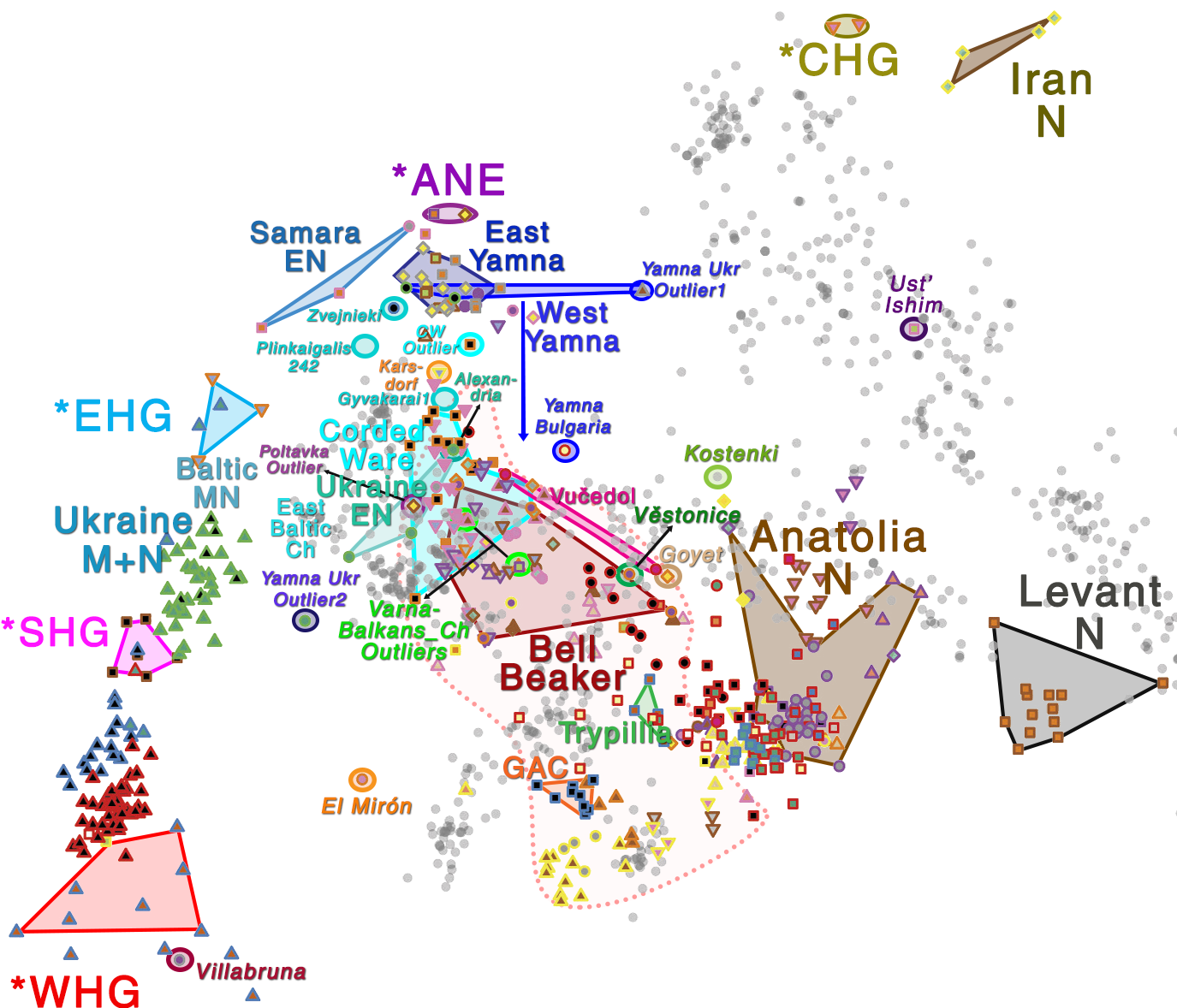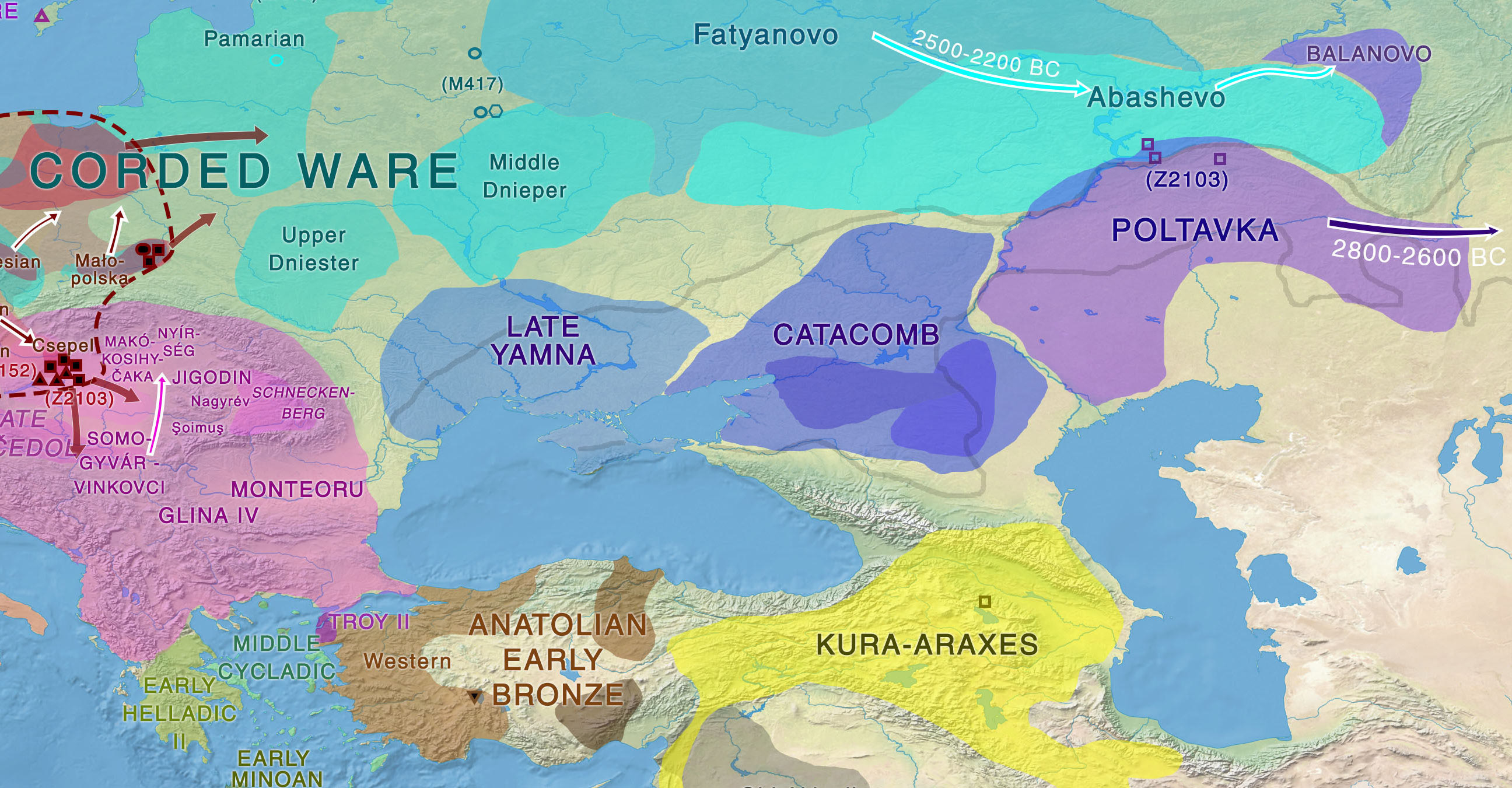This is the first of a series of posts analyzing the findings of the recent Nature papers Olalde et al.(2018) and Mathieson et al.(2018) (abbreviated O&M 2018).
As expected, the first Y-DNA haplogroup of a sample from the North Pontic region (apart from an indigenous European I2 subclade) during its domination by the Yamna culture is of haplogroup R1b-L23, and it is dated ca. 2890-2696 BC. More specifically, it is of Z2103 subclade, the main lineage found to date in Yamna samples. The site in question is Dereivka, “in the southern part of the middle Dnieper, at the boundary between the forest-steppe and the steppe zones”.
NOTE: A bit of history for those lost here, which appear to be many: the classical Yamna culture – from previous late Khvalynsk, and (probably) Repin groups – spread west of the Don ca. 3300 BC creating a cultural-historical community – and also an early offshoot into Asia – , with mass migrations following some centuries later along the Danube to the Carpathian Basin, but also south into the Balkans, and north along the Prut. There is thus a very short time frame to find Yamna peoples shaping these massive migrations – the most likely speakers of Late Proto-Indo-European dialects – in Ukraine, compared to their most stable historical settlements east of the Don River.
There is no data on this individual in the supplementary material – since Eneolithic Dereivka samples come from stored dental remains – , but the radiocarbon date (if correct) is unequivocal: the Yamna cultural-historical community dominated over that region at that precise time. Why would the authors name it just “Ukraine_Eneolithic”? They surely took the assessment of archaeologists, and there is no data on it, so I agree this is the safest name to use for a serious paper. This would not be the first sample apparently too early for a certain culture (e.g. Catacomb in this case) which ends up being nevertheless classified as such. And it is also not impossible that it represents another close Ukraine Eneolithic culture, since ancestral cultural groups did not have borders…
NOTE. Why, on the other hand, was the sample from Zvejnieki – classified as of Latvia_LN – assumed to correspond to “Corded Ware” (like the recent samples from Plinkaigalis242 or Gyvakarai1), when we don’t have data on their cultures either? No conspiracy here, just taking assessments from different archaeologists in charge of these samples: those attributed to “Corded Ware” have been equally judged solely by radiocarbon date, but, combining the known archaeological signs of herding in the region arriving around this time with the old belief (similar to the “Iberia is the origin of Bell Beaker peoples” meme) that “only the Corded Ware culture signals the arrival of herding in the Baltic”. This assumption has been contested recently by Furholt, in an anthropological model that is now mainstream, upheld also by Anthony.
We already know that, out of three previous West Yamna samples, one shows Anatolian Neolithic ancestry, the so-called “Yamna outlier”. We also know that one sample from Yamna in Bulgaria also shows Anatolian Neolithic ancestry, with a distinct ‘southern’ drift, clustering closely to East Bell Beaker samples, as we can still see in Mathieson et al. (2018), see below. So, two “outliers” (relative to East Yamna samples) out of four samples… Now a new, fifth sample from Ukraine is another “outlier”, coinciding with (and possibly somehow late to be a part of) the massive migration waves into Central Europe and the Balkans predicted long ago by academics and now confirmed with Genomics.
I think there are two good explanations right now for its ancestral components and position in PCA:

a) The most obvious one, that the Dnieper-Dniester territory must have been a melting pot, as I suggested, a region which historically connected steppe, forest steppe, and forest zone with the Baltic, as we have seen with early Baltic Neolithic samples (showing likely earlier admixture in the opposite direction). The Yamna population, a rapidly expanding “elite group of patrilineally-related families” (words from the famous 2015 genetic papers, not mine), whose only common genetic trait is therefore Y-DNA haplogroup R1b-L23, must have necessarily acquired other ancestral components of Eneolithic Ukraine during the migrations and settlements west of the Don River.
How many generations are needed for ancestral components and PCA clusters to change to that extent, in regions where only some patrilocal chiefs but indigenous populations remain, and the population probably admixed due to exogamy, back-migrations, and “resurge” events? Not many, obviously, as we see from the differences among the many Bell Beaker samples of R1b-L23 subclades from Olalde et al. (2018)…
b) That this sample shows the first genetic sign of the precise population that contributed to the formation of the Catacomb culture. Since it is a hotly debated topic where and how this culture actually formed to gradually replace the Yamna culture in the central region of the Pontic-Caspian steppe, this sample would be a good hint of how its population came to be.
See e.g. for free articles on the Catacomb culture its article on the Encyclopedia of Indo-European Culture, Catacomb culture wagons of the Eurasian steppes, or The Warfare of the Northern Pontic Steppe – Forest-Steppe Pastoral Societies: 2750 – 2000 B.C. There are also many freely available Russian and Ukrainian papers on anthropometry (a discipline I don’t especially like) which clearly show early radiocarbon dates for different remains.
This could then be not ‘just another West Yamna outlier’, but would actually show meaningful ‘resurge’ of Neolithic Ukraine ancestry in the Catacomb culture.
It could be meaningul to derive hypotheses, in the same way that the late Central European CWC sample from Esperstedt (of R1a-M417 subclade) shows recent exogamy directly from the (now more probably eastern part of the) steppe or steppe-forest, and thus implies great mobility among distant CWC groups. Although, given the BB samples with elevated steppe ancestry and close PCA cluster from Olalde et al. (2018), it could also just mean exogamy from a near-by region, around the Carpathian Basin where Yamna migrants settled…
If this was the case, it would then potentially mean a “continuity” break in the steppe, in the region that some looked for as a Balto-Slavic homeland, and which would have been only later replaced by Srubna peoples with steppe ancestry (and probably R1a-Z93 subclades). We would then be more obviously left with only two options: a hypothetic ‘Indo-Slavonic’ North Caspian group to the east (supported by Kortlandt), or a Central-East European homeland near Únětice, as one of the offshoots from the North-West Indo-European group (supported by mainstream Indo-Europeanists).
How to know which is the case? We have to wait for more samples in the region. For the moment, the date seems too early for the known radiocarbon dating of most archaeological remains of the Catacomb Culture.

An important consequence of the addition of these “Yamna outliers” for the future of research on Indo-European migrations is that, especially if confirmed as just another West Yamna sample – with more, similar samples – , early Palaeo-Balkan peoples migrating south of the Danube and later through Anatolia may need to be judged not only in terms of ancestral components or PCA (as in the paper on Minoans and Mycenaeans), but also and more decisively using phylogeography, especially with the earliest samples potentially connected with such migrations.
NOTE. Regarding the controversy (that some R1b European autochthonous continuists want to create) over the origin of the R1b-L151 lineages, we cannot state its presence for sure in Yamna territory right now, but we already have R1b-M269 in the eastern Pontic-Caspian steppe during the Neolithic-Chalcolithic transition, then R1b-L23 and subclades (mainly R1b-Z2013, but also one xZ2103, xL51 which suggests its expansion) in the region before and during the Yamna expansion, and now we have L51 subclades with elevated steppe ancestry in early East Bell Beakers, which most likely descended from Yamna settlers in the Carpathian Basin (yet to be sampled).
Even without express confirmation of its presence in the steppe, the alternative model of a Balkan origin seems unlikely, given the almost certain continuity of expanding Yamna clans as East Bell Beaker ones, in this clearly massive and relatively quick expansion that did not leave much time for founder effects. But, of course, it is not impossible to think about a previously hidden R1b-L151 community in the Carpathian Basin yet to be discovered, adopting North-West Indo-European (by some sort of founder effect) brought there by Yamna peoples of exclusively R1b-Z2103 lineages. As it is not impossible to think about a hidden and ‘magically’ isolated community of haplogroup R1a-M417 in Yamna waiting to be discovered…Just not very likely, either option.
As to why this sample or the other Bell Beaker samples “solve” the question of R1a-Z645 subclades (typical of Corded Ware migrants) not expanding with Yamna, it’s very simple: it doesn’t. What should have settled that question – in previous papers, at least since 2015 – is the absence of this subclade in elite chiefs of clans expanded from Khvalynsk, Yamna, or their only known offshoots Afanasevo and Bell Beaker. Now we only have still more proof, and no single ‘outlier’ in that respect.
No haplogroup R1a among hundreds of samples from a regionally extensive sampling of the only cultures mainstream archaeologists had thoroughly described as potentially representing Indo-European-speakers should mean, for any reasonable person (i.e. without a personal or professional involvement in an alternative hypothesis), that Corded Ware migrants (as expected) did not stem from Yamna, and thus did not spread Late Indo-European dialects.
This haplogroup’s hegemonic presence in North-Eastern Europe – and the lack of N1c lineages until after the Bronze Age – coinciding with dates when Uralicists have guesstimated Uralic dialectal expansion accross this wide region makes the question of the language spread with CWC still clearer. The only surprise would have been to find a hidden and isolated community of R1a-Z645 lineages clearly associated with the Yamna culture.
NOTE. A funny (however predictable) consequence for R1a autochthonous continuists of Northern or Eastern European ancestry: forum commentators are judging if this sample was of the Yamna culture or spoke Indo-European based on steppe component and PCA cluster of the few eastern Yamna samples which define now (you know, with the infallible ‘Yamnaya ancestral component’) the “steppe people” who spoke the “steppe language”™ – including, of course, North-Eastern European Late Neolithic…
Not that radiocarbon dates or the actual origin of this sample cannot be wrong, mind you, it just strikes me how twisted such biased reasonings may be, depending on the specific sample at hand… Denial, anger, and bargaining, including shameless circular reasoning – we know the drill: we have seen it a hundred times already, with all kinds of supremacists autochthonous continuists who still today manage to place an oudated mythical symbolism on expanding Proto-Indo-Europeans, or on regional ethnolinguistic continuity…
More detailed posts on the new samples from O&M 2018 and their consequences for the Indo-European demic diffusion to come, indeed…
See also:
- Olalde et al. and Mathieson et al. (Nature 2018): R1b-L23 dominates Bell Beaker and Yamna, R1a-M417 resurges in East-Central Europe during the Bronze Age
- Reactionary views on new Yamna and Bell Beaker data, and the newest IECWT model
- The Indo-European demic diffusion model, and the “R1b – Indo-European” association
- The concept of “Outlier” in Human Ancestry (III): Late Neolithic samples from the Baltic region and origins of the Corded Ware culture
- The renewed ‘Kurgan model’ of Kristian Kristiansen and the Danish school: “The Indo-European Corded Ware Theory”
- Correlation does not mean causation: the damage of the ‘Yamnaya ancestral component’, and the ‘Future America’ hypothesis
- New Ukraine Eneolithic sample from late Sredni Stog, near homeland of the Corded Ware culture
- Something is very wrong with models based on the so-called ‘Yamnaya admixture’ – and archaeologists are catching up (II)
- Germanic–Balto-Slavic and Satem (‘Indo-Slavonic’) dialect revisionism by amateur geneticists, or why R1a lineages *must* have spoken Proto-Indo-European